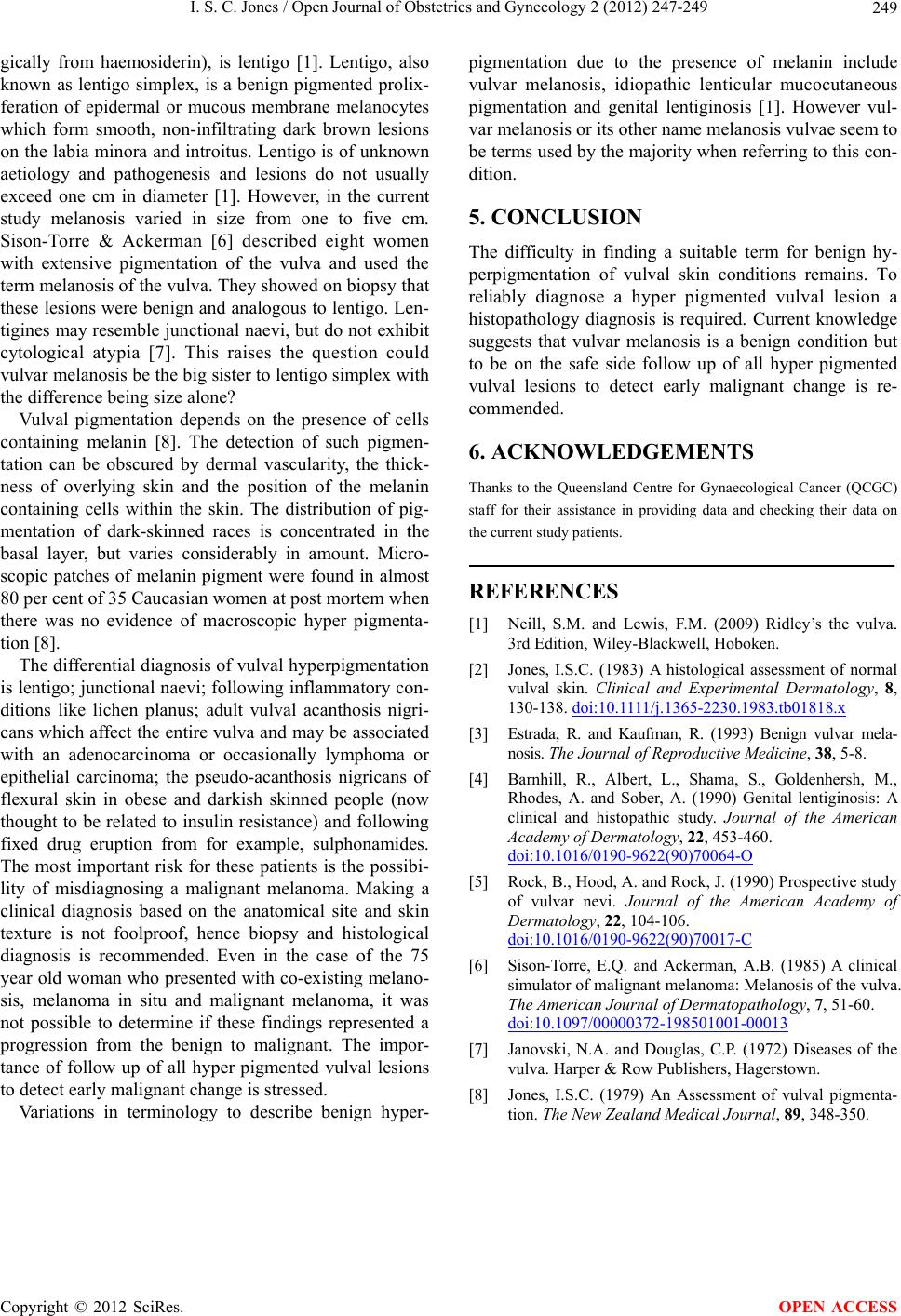
I. S. C. Jones / Open Journal of Obstetrics and Gynecology 2 (2012) 247-249
Copyright © 2012 SciRes.
249
gically from haemosiderin), is lentigo [1]. Lentigo, also
known as lentigo simplex, is a benign pigmented prolix-
feration of epidermal or mucous membrane melanocytes
which form smooth, non-infiltrating dark brown lesions
on the labia minora and introitus. Lentigo is of unknown
aetiology and pathogenesis and lesions do not usually
exceed one cm in diameter [1]. However, in the current
study melanosis varied in size from one to five cm.
Sison-Torre & Ackerman [6] described eight women
with extensive pigmentation of the vulva and used the
term melanosis of the vulva. Th ey show ed on b iopsy that
these lesions were benign and analogous to lentigo. Len-
tigines may resemble junctional naev i, but do not exhibit
cytological atypia [7]. This raises the question could
vulvar melanosis be the big sister to lentigo simplex with
the difference being size alone?
OPEN ACCESS
Vulval pigmentation depends on the presence of cells
containing melanin [8]. The detection of such pigmen-
tation can be obscured by dermal vascularity, the thick-
ness of overlying skin and the position of the melanin
containing cells within the skin. The distribution of pig-
mentation of dark-skinned races is concentrated in the
basal layer, but varies considerably in amount. Micro-
scopic patches of melanin pigment were found in almost
80 per cent of 35 Caucasian women at post mortem when
there was no evidence of macroscopic hyper pigmenta-
tion [8].
The differential diagnosis of vulval hyperpigmentation
is lentigo; junction al naevi; following inflammatory con-
ditions like lichen planus; adult vulval acanthosis nigri-
cans which affect the entire vulva and may be associated
with an adenocarcinoma or occasionally lymphoma or
epithelial carcinoma; the pseudo-acanthosis nigricans of
flexural skin in obese and darkish skinned people (now
thought to be related to insulin resistance) and following
fixed drug eruption from for example, sulphonamides.
The most important risk for these patients is the possibi-
lity of misdiagnosing a malignant melanoma. Making a
clinical diagnosis based on the anatomical site and skin
texture is not foolproof, hence biopsy and histological
diagnosis is recommended. Even in the case of the 75
year old woman who presented with co-existing melano-
sis, melanoma in situ and malignant melanoma, it was
not possible to determine if these findings represented a
progression from the benign to malignant. The impor-
tance of follow up of all hyper pigmented vulval lesions
to detect early malignant change is stressed.
Variations in terminology to describe benign hyper-
pigmentation due to the presence of melanin include
vulvar melanosis, idiopathic lenticular mucocutaneous
pigmentation and genital lentiginosis [1]. However vul-
var melanosis or its other name melanosis vulvae seem to
be terms used by the majority when referring to this con-
dition.
5. CONCLUSION
The difficulty in finding a suitable term for benign hy-
perpigmentation of vulval skin conditions remains. To
reliably diagnose a hyper pigmented vulval lesion a
histopathology diagnosis is required. Current knowledge
suggests that vulvar melanosis is a benign condition but
to be on the safe side follow up of all hyper pigmented
vulval lesions to detect early malignant change is re-
commended.
6. ACKNOWLEDGEMENTS
Thanks to the Queensland Centre for Gynaecological Cancer (QCGC)
staff for their assistance in providing data and checking their data on
the current study patients.
REFERENCES
[1] Neill, S.M. and Lewis, F.M. (2009) Ridley’s the vulva.
3rd Edition, Wiley-Blackwell, Hoboken.
[2] Jones, I.S.C. (1983) A histological assessment of normal
vulval skin. Clinical and Experimental Dermatology, 8,
130-138. doi:10.1111/j.1365-2230.1983.tb01818.x
[3] Estrada, R. and Kaufman, R. (1993) Benign vulvar mela-
nosis. The Journal of Reproductive Medicine, 38, 5-8.
[4] Barnhill, R., Albert, L., Shama, S., Goldenhersh, M.,
Rhodes, A. and Sober, A. (1990) Genital lentiginosis: A
clinical and histopathic study. Journal of the American
Academy of Dermatology, 22, 453-460.
doi:10.1016/0190-9622(90)70064-O
[5] Rock, B., Hood, A. and Rock, J. (1990) Prospective study
of vulvar nevi. Journal of the American Academy of
Dermatology, 22, 104-106.
doi:10.1016/0190-9622(90)70017-C
[6] Sison-Torre, E.Q. and Ackerman, A.B. (1985) A clinical
simulator of mali gnant melanoma: Melanosis of the vulva.
The American Journal of Dermatopathology, 7, 51-60.
doi:10.1097/00000372-198501001-00013
[7] Janovski, N.A. and Douglas, C.P. (1972) Diseases of the
vulva. Harper & Row Publishers, Hagerstown.
[8] Jones, I.S.C. (1979) An Assessment of vulval pigmenta-
tion. The New Zealand Medical Journal, 89, 348-350.